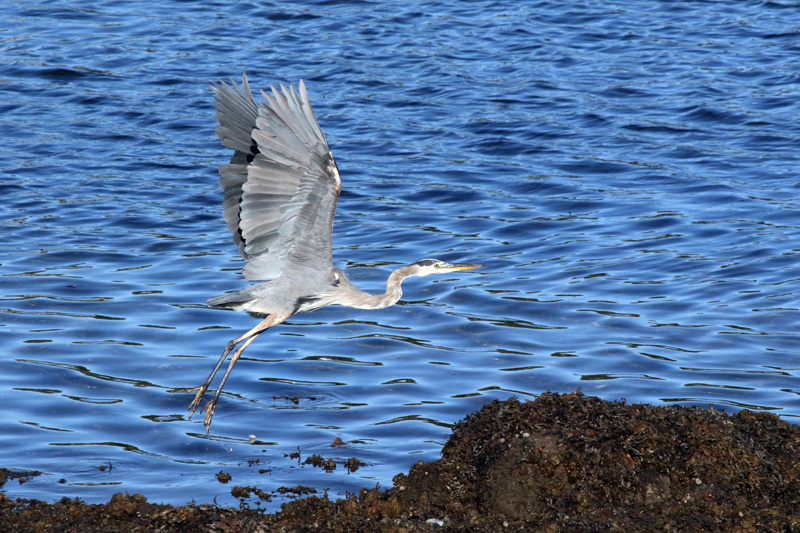
A great blue heron takes flight in Pemaquid Harbor. (Photo courtesy Robert Thorpe)
If I had to pick one local bird to symbolize the Damariscotta River and coastal Lincoln County, it would be the great blue heron. A denizen of local tidal areas and wetlands, these large birds make a primordial squawking. At night, the sound can be downright sinister. As a child, I remember my grandmother, Margo Kornahrens, relaying that great blue herons sounded like someone in distress in the dark. We would hear them late in the evening, hunting along the edges of the nearby shoreline in South Bristol.
Despite their eerie nocturnal racket, great blue herons are usually quite secretive. When I stumble across them near the river, they don’t hang around. Letting out an annoyed (or perhaps alarmed) croak, they quickly take to the sky. They can be found in isolated coves, swamps, lakeshores, and tidal flats. You may also see them in small, freshwater ponds.
With their large blade-shaped bills, great blue herons grab or impale a variety of prey. Beyond fish, these birds also eat crabs, snakes, salamanders, frogs, rodents, insects, and even turtles. Smaller birds, including ducklings, may also be taken, depending on their availability. Hunting can occur at various times of the day and involves the heron standing in a stationary position or moving slowly.
Here during the summer breeding season, great blue herons spend the winter anywhere from the Caribbean to the northern reaches of South America. Breeding occurs in colonies that are often located in remote wetlands or on islands. Nests are found within trees, in shrubs, and in structures like channel markers. Communal wetland nesting sites, known as heronries, can have upward of 500 nests.
Threats to great blue herons include habitat loss and human disturbance near nest sites. In the past, they were shot by hunters. Saltwater birds, herons also face threats from chemical pollutants and plastic debris. Although quite common, the future of the species will be determined by human action. If wetland breeding colonies are left intact and natural foods remain plentiful, the future will remain bright. Presently, the population is listed as stable.
Like all birds, great blue herons require food, water, cover, and adequate places to nest. Remote coves and quiet stretches of riverside will be where you can find these agile, patient birds. I had the privilege of seeing a group migrating in mid-April. Flying over my street in Newcastle, they reminded me of winged dinosaurs.
Migration is nothing short of a miracle. The fact that our breeding birds can find their way back to Maine each spring is a wondrous feat. Beyond herons, I have noticed the April return of the eastern phoebe, the yellow-bellied sapsucker, and the ethereal-sounding hermit thrush. In a matter of days, backyards will again host ruby-throated hummingbirds, Baltimore orioles, and gray catbirds. Warblers, avian royalty, have begun to trickle back as well.
Finally, this is my last column. After writing “Backyard Wildlife” for the past two years, I am stepping back and saying farewell. Thank you to J.W. Oliver and The Lincoln County News for hosting this column. I also want to thank Robert Thorpe for generously sharing some of his photos.
And to the regular readers of “Backyard Wildlife,” thank you. I have appreciated your emails, your cards, and your questions. Please feel free to stay in touch via email or visit my Facebook page.
It is heartening to realize how many people out there care about wildlife.
To paraphrase Tom Brokaw, you’ll see this newspaper next week, and I’ll see you along the way.



